Varta APC/MRAP (2016)
 Armoured Personal Carrier: 80 delivered 2015-2019.
Armoured Personal Carrier: 80 delivered 2015-2019.
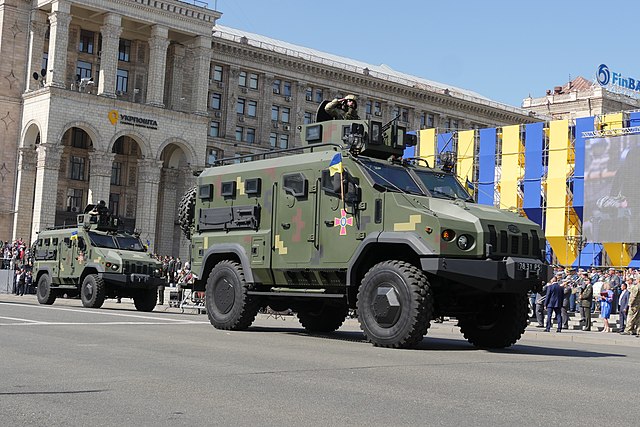
Varta MRAP paraded on August 24 2018 in the main street at Khreschatyk, for the celebration of the 27th anniversary of the Independence of Ukraine. (Uk MoD CC photo via Flickr)
Ukrarmor and development of the Varta
The Ukrainian private company “Ukrainian Armored Vehicles” registered in Kyiv started the APC as its first line product and create a demonstration model first presented on December 7, 2015 in Kyiv. As the Minister of Internal Affairs of Ukraine A. B. Avakov said in an interview, the Ministry of Internal Affairs of Ukraine has entered into a preliminary agreement for the supply of ten armored vehicles by the end of 2015, later handed over to the police special forces KORD and National Guard of Ukraine, with and option order to 100 armored vehicles of the Varta APC type.On the same day, Secretary of the National Security and Defense Council of Ukraine A.V. Turchynov reported that the cost of one Varta SBA is about 5 million hryvnia per vehicle. In addition, he started that to increase competition between Ukrainian armored vehicle manufacturers that field tests of the Varta would be made in combat zone in eastern Ukraine (Donbass front) before mass acquisition. As of December 16, 2015, the Ministry of Internal Affairs tested a single vehicle, with a contract for additional number not approved. This demonstrator was powered by a YaMZ engine rated for 270 hp with prospects to install a Cummins engine rated for 300 hp considered for a time.
By March 2016, the Varta prototype took part in tests conducted by the State Research and Testing Center of the Armed Forces of Ukraine at the Chernigov Oblast training ground and by April 2016, the production cost was estimated at 5.5 - 7.5 million hryvnia. By April 13, 2016, it was announced the unitary cost for ten Varta as ordered by the KORD special police was reevaluated to 5.8 million hryvnia, delivered without combat module.
By October 2017, reports pressed changes to the chassis and by December 28, the first batch was transferred to the Ukrainian MoD for reception, and by February 2019, another 15 were delivered to the 88th air assault battalion of the Ukrainian Naval Infantry Marine Corps. From the 8th in production, the 6-cylinder Weichai turbo-diesel engine rated for 380 hp and torque of 1460 Nm was tested.
By December 15, the first demonstration of the “Varta-Novator” (hence confusion later) was first presented to the general staff of the National Guard of Ukraine. In June 2018, this new vehicle was presented to the Minister of Defense S. T. Poltorak this time simply as “Novator” and proposed for the armed forces, and by October 9, 2018, an armed version sporting a Stugna-P ATGM launcher installed in the back was presented at the Kiev arms exhibition. On November 15, 2018, some of the preserie vehicles were handed over to the troops for further evaluation and by November 15, 2019, the first 40 were accepted by the Ukrainian Army.
Design of the Varta APC/MRAP
As stated on the website itself:"VARTA – is an Armored Personnel Carrier (APC). It is ideal for transporting soldiers in combat situations and can also be equipped as a Command-Post Vehicle, or evacuation of troops. The vehicle compartment is made from specialized 560 steel grade which protects crew from armored piercing incendiary ammo up to 7.62mm. VARTA uses a V-shape hull structure to accommodate anti-mine seats, giving crew members protection to withstand detonation of charges up to 6kg of TNT. VARTA includes a fighting module equipped with either the 7.62 mm or the 12.7 mm machine gun. The vehicle has 10 gun ports around the vehicle with the feasibility of accommodating a UBGL (Under-Barrel Grenade Launcher)."
Hull and overall design

Official presentation (from pinterest)
Designed earlier than the Novator, it was the company's first entry, tested back in 2014-2015 and entering service in 2016. Apart the hull sharing its distinctive nose and calander, this is a much bulkier vehicle compared to the Novator. The first is indeed a recce vehicle with heavier weapons, greater speed and reduced crew. The second is a long-range, modular 4x4 troop transport lighty armed and protected against infantry fire and small mines.
The monoblock hull, called the "armored capsule" is made of Swedish 560 Steel Armor, with a forward driver/cro-driver compartment behind two rectangular armoured glass windows without armored shutter, and two doors either side, one for the cabin and one for the rear compartment with four infantry seated, facing the windows and gun ports, equiped with powder gases ventilation system. Five of them are located on either side, three under the rear windows, one on each door behind a small "L" shaped window also with thick frame for triple armoured glass.
The vehicle has all schock-prone outer elements in durable reinforced plastic, the black bumper (integrating the main winch), and roadwheels arches protections. It has protection for its four main lights inside the forward arches and over extra roof lights. The conventional layout with front engine, cabin and rear troop compartment was, According to the MoFA A. B. Avakov by December 7, 2015 provided foreign-made components. It had a welded ARMOX 560 shell; at its rear ws located a main door for landing and disembarking troops and mount for a spare wheel. All armored doors have handles and locks from TriMark Corporation. There are also two rear roof hatches as supplementary exits.
Protection

Official pres. photo from D. Malyasov, Pinterest
The bottom of the armored vehicle is armored, its lower part is V-shaped to increase mine resistance and shield the crew from a blast, venting it outwards, up to six kilograms of TNT. The seats for crew members and troops inside the compartment are all suspended, mine-resistant thanks to shock-absorbing fastenings, headrests and folding integrally in order to clear the floor to transport cargo with a useful payload of 2 tons. These anti-mine seats were tested at STANAG 4569 protection level, NATO AEP-55 standard, having an advanced energy damper attenuation system, 5 point seatbelt system and waterproof external coating.
The armour shell protects on all angles from AP 7.62 mm bullets at 10 meters. Mine blasts under the wheels were done, showing the vehicle could still come back to base on three wheels. All 8 mm bullet resistant armoured glass panels are installed in frames for easy replacement. The vehicle has no smoke projectors but is collectively NBC protected, with an air filter and overpressure to deflect atmospheric pollution, nuclear blasts, and toxic contaminations. There is also an integral high speed fire suppression system in the crew and engine compartments, notably reacting in case of a “Molotov cocktail” or resulting effects of an RPG attack. It had an UV IR detector reacting in 3 milliseconds with a fire suppression time of 250 milliseconds.
Powerplant and Mobility
The vehicle is provided with a Varta V, 6-cylinder multifuel turbo diesel, rated for 380 hp and a torque of 1250 Nm at 1200-1600 rpm. It has four 14,00 R 20 or 16,00 R 20 military grade, run-flat tyres with a central inflation system. The gine is coupled with a 9 Gear Manual Transmission. This two-axle truck base “high-cross” chassis could be loaded up to 8.15 tons. Top speed on trials was 120 kph but in full load c100 kph and it is assorted with a 350 liter tank capacity for a range of 600 kp on road. It is provided with a 24V electrical system to feed it whe the engine is cold.The central tyre inflation system manages air pressure depending on road surface automatically, and maintain a specified air pressure in case of damage and a wheel disconnection in case of significant damage and detected air leakage. The Run-flat tires allowed to run 40 km off road. Each are divided into three parts for quick mounting without special equipment. To access the engine, the bonnet is hinged forward down to its bumper supports, with hydraulic arms and locker, and two handles. The vehicle is amphibious witout preparation, being able to ford up to 750 mm of water, and the engine is equipped with an upper external air intake. The Varta had a wheelbase of 3,950 mm, a ground clearance of 330 mm, can negociate a side slope of 20º and a gradient of 25º.
Equipments
The Varta APC comes out with an Independent air conditioning and heating system to provided a constant internal climate under -40 to +50 °C. All windows and mirrors are heated as well for the ukrainian winter and the ergonomic dashboad is waterproof, with anti shock sensors and switches. The 300 kgs force heavy-duty doors are compliant to FMVSS 206 strength requirements. There is an electric shock/water proof winch, with a towing capacity 9 t, synthetic rope/steel cable of 25 m, which can received an optional set of pulley blocks.The vehicle comprises front headlights, taillights, brake lights, marker lights, direction indicators, fog lights, convoy lights, spotlights and blackout lights made in polycarbonate materials instead of glass, dust, water and chalk-resistant. There are setting for internal lihting as well, meeting NATO standards. Blackout lights are using special lenses to cast a diffused horizontal beam for night convoys. There are two sets of foldable arm-strapped military grade platic back mirrors either side, the front windows had base-mounted wipers, handles are provided to the main doors and a step. At the rear of the vehicle, below the pistol ports are located two self-unditching ramps.
Armament
The basic APC was shown with a semi-protected half-turret style combat hatch and pannier for a standing operator. The universal mount on 360° ring is equipped with a power-assisted mount for high elevation wether it carried a standard NATO 7.62 mm GMPG or assimilated light machine gun (PK module) or a heavier "Sarmat" module 12.7 mm, Browning or Kord heavy machine gun. The gunner station is complete with it full protection kit, an the back is protected by the hatch lifted up, hinged back. The vehicle was designed also to carry an enclosed cupola with both the 14.5mm and coaxial 7.62 mm LMG, in manual and powered variants. Smoke grenade launching system are optional.The first demonstration was armed with a 12.7 mm NSVT machine gun mounted in the roof open turret but it was designed to house a 550 kg combat module BPU-1 turret with a 14.5-mm KPVT machine gun and coaxial 7.62-mm PKT coaxial machine gun initially developed in USSR for the BRDM-2, BTR-70 and BTR-80, or a RWS combat module with alternatove 7.62 mm or 12.7 mm machine gun.
Operational Records
The National Guard of Ukraine were the first to obtain the "Varta-2", purchasing 10 vehicles and an extra 60 vehicles. The first were delivered at the end of 2015 for tests, with a further 15 delivered to the 88th air assault battalion of the Ukrainian Naval Infantry Marine Corps and the 8th operational regiment of the NSU. So far 37 had been lost in the current war in Ukraine, meaning the bulk of the initial order is gone, among which 25 captured. 80 were delivered to the armed forces of ukraine as of January 2023.Variants
The Varta Ambutank
Tailored version for medical evacuation. The interrior space is revised to carry four stretchers and seats for four extra injured soldiers and two medical staff. it could be reconfigured as Command-Post Vehicle. On the back plate, to the left is located an external access medical stowage. There is also a large step to help climbing in. At least one demonstrator built. The sanitary and medical version Varta-2 was demonstrated on October 10, 2017 at the weapons exhibition “Zbroya and Bezpeka-2017” held in Kyiv, weighting 17 tons.Smereka
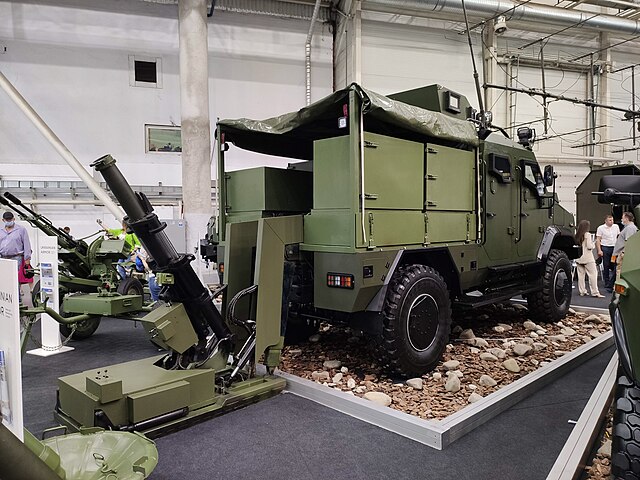
The rear configuration allows to carry an automated mobile mortar system stowed on the back platform and lowed hydraulically to the ground behind the vehicle, on its base plate for firing. 120 mm caliber, with 40 rounds in racks on the rear compartment. One demonstrator vehicle was produced. It was presented as "Zbroya and Bezpeka-2021".
Sokil
The rear compartment is configured both to operate observation or combat drones, and a command post. The reconnaissance-strike complex (RSC) SOKIL is geared for observation, detection, tracking and destruction of enemy assets, fitted with a lightweight weapon station, communications facilities and tailored equipment such and digital displays and an operating gear for launching reconnaissance and strike unmanned aircraft systems, bu also tracking systems for day and night operations (thermal imaging camera) and datalink of target position to the command post as well as an extended radius, above 10 km of search and strike with unmanned systems. So far, stays as a concept.Evolution: The Kamrat-L armored vehicle

The heavier Kamrat-L, still called "Varta" is based on the KrAZ-5233 truck chassis, and its development was announced in February 2020. It has an even more refined modular design for extra customization, notably as drone control, medical, NBC vehicle or mobile mortar system and still under STANAG 4569 standards level 2 (small armed from 30 meters, mines up to 6 kg TNT under any wheel, belly) and had the same chassis and shares 95%+ components, incuding its 6-cylinder in-line turbocharged diesel engine (270 or 380 h, torque 1,128 or 1,250 Nm). On the website, it is now called the Kamrat C-130, is more powerful, better protected, and features in APC KAMRAT configuration the combat unit “Sarmat” (12.7 mm HMG) complete with the anti-tank missile system “Corsar” (107 mm) or “Skif” (130 mm and 152 mm caliber). It is otherwise near identical. In April 2019, the KrAZ-6322 truck was also tested with the same armoured cell as the Varta.
Varta APC | |
| Dimensions | 8 x 2.6 m x 3.6 m |
| Total weight, battle ready | 17 tonnes |
| Crew | 2(+8) |
| Propulsion | 6L IL TD 380 hp, 1,250 N/m at 1200-1600 rpm |
| Suspension | Schock absorbers |
| Speed (road) | 100 km/h |
| Range | 350 litres, 1000 km |
| Armament | LMG or HMG, small arms |
| Armor | Stanag 4569 Lvl 2 |
| Production so far | 80 (2023) |
Gallery
Illustrations
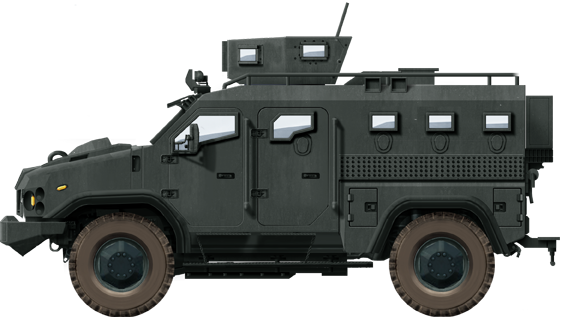
Vehicle of the Kord Special Police in a dark grey livery
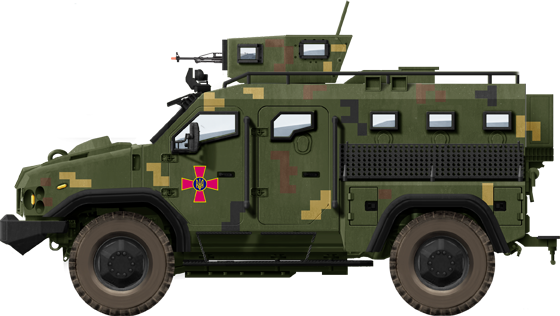
Vehicle of the 88th air assault battalion of the Ukrainian Naval Infantry Marine Corps
Photos

Demonstrator in 2015 in Kiev

Demonstrator in the forest

Vehicle of the 88th air assault battalion of the Ukrainian Naval Infantry Marine Corps in parade, Kiev 2022

Vehicle of the National Guard in parade, Kiev 2017

Varta underway (Ytube)

Varta underway (Ytube)

Varta testing a RK-2S RWS LMG/ATGMs combo (pint)
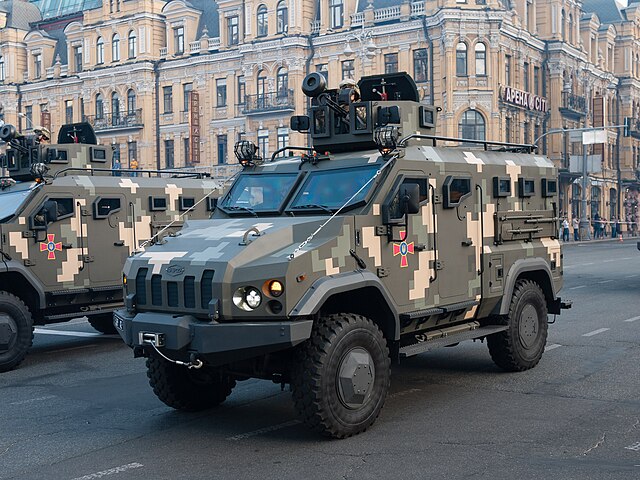
Varta in Kiev 2021
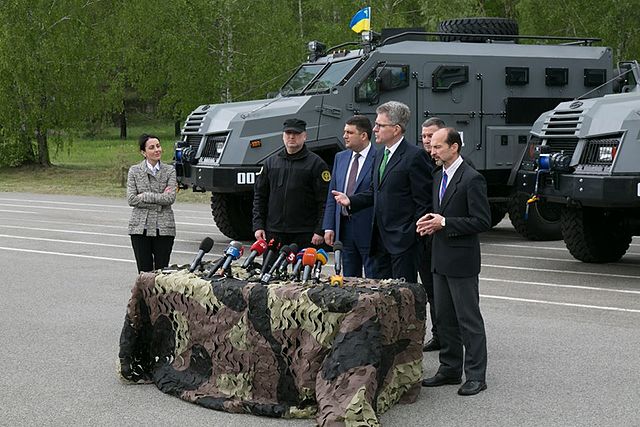
Vehicle of the Kord special Police
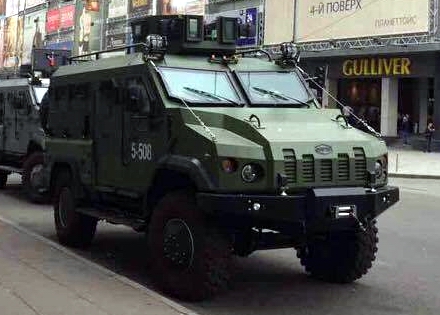
Varta of the National Guard
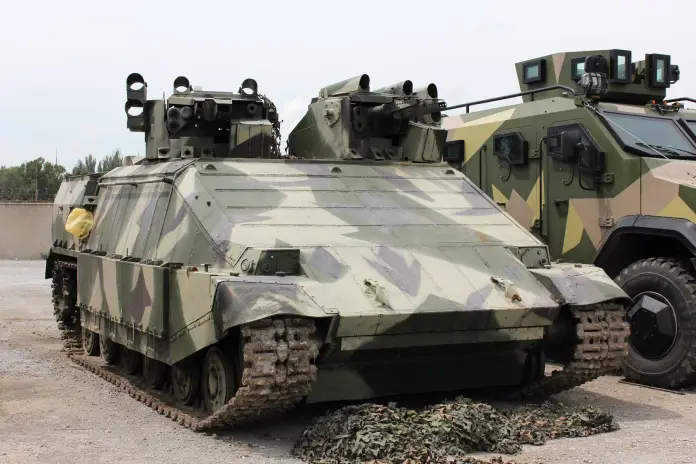
Camouflaged Varta close to the captured Ukrainian Azovets improvized APC
Sources/Links
ukrarmor.com21stcenturyasianarmsrace.com
army-technology.com
armyrecognition.com
sofrep.com
sofrep.com
On ru.wikipedia.org
defence-blog.com upgraded-varta-armored-vehicle
forbes.com/sites/davidaxe
armyrecognition.com 2016 trials of the Varta
twitter.com/UAWeapons
defence-blog.com
en.defence-ua.com Varta to Morocco
UKR losses on oryxspioenkop.com
On Linkedin
en.defence-ua.com
Videos

Modern Tanks
Modern MBTs posters

Denel Bagder (2018)

Type 16 MCV (2016)

Gepard 1A2 last rounds 2011

SANDF

Russian AFVs

Main Battle Tanks